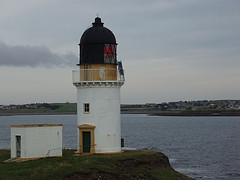
The Guga Hunters
By Norma MacRitchie
Back in the Day, September/October 2006
It’s that time of year again, when the Niseachs eagerly await the return of their men with a boat laden with their gourmet delicacy – the guga – due to return this week. Annually, towards the end of August, ten hardy men set sail, 40 miles northwest of the Butt to the uninhabited rock of Sula Sgeir for the two week expedition. It is only the men from Ness that are allowed, under special license from EU law, to hunt the young gannets on the island, with the blessing of both the Royal Society for the Protection of Birds and the Scottish Society for the Prevention of Cruelty to Animals, under special dispensation. More and more people want to sample the young gannet, for what used to be a speciality confined to the Ness area is now being sold much further afield. The guga has even attracted guru chef Gordon Ramsay and his film crew to investigate the annual pilgrimage. Local lady, Mary Anne Morrison, travelled down to London, where the guga was sampled in Ramsay’s restaurant and broadcast on his TV programme “The F-word” – let’s just say it did not satisfy the palate of a certain Frenchman – the one whose cuisine consists of snails and frog’s legs.
The Niseachs have a long association with Sula Sgeir. Dean Munro, writing from personal experience in the 16th century, declares: “Men out of the Parish of Ness in Lewis sail and tarry there seven or eight days, and to fetch with them home their boatful of dry wild fowls and feathers”.
In those early days, they made the journey in rowing boats. Later, it was open skiffs (sgoths) – the last was in 1947, which marked the end of an era. The sgoth used to be hauled about 60 feet up the steep, rocky shelf.
In the present day, a fishing boat takes the men and their supplies out and returns for them, weather permitting, after a fortnight.
John “Dodds” MacFarlane, Alasdair “Ban” Campbell and Donald “Beagaidh” Morrison talk about their experiences and what they endure on the desolate island for two weeks.
Dodds began going to Sula Sgeir 32 years ago, learning from the experienced men, and is now the one leading the group. He begins: “The first day we arrive, we haul up all the gear which is quite heavy going. We haul it up the very steep rock face, with the aid of a pulley or block and tackle. The men live in stone huts built many years ago with slabs of rock. One of the buildings is reputed to be an old chapel, and the tradition was, when Rona was still inhabited, that Sula Sgeir was used as some sort of prison or house of correction. The island itself is just a rock, bare of all grass and riddled with nooks and crannies which makes the climbing up and down the rockface accessible only to the experienced men. The Atlantic seas have burrowed right through the southern part of the island in a series of interconnected and impressive caves.”
Dodds continues: “When we go out killing, we split into two
groups - 5 in one and 4 in another – and in each group there is someone with a
rod to catch the birds and the others are responsible for killing them. If we
are working on the edge of the cliffs, one group goes one way and the other
group goes the other way so that we are always working together and keeping
away from the edge. When we are working on the rocks you don’t get that many
birds so just one person does that. After the men have enough birds to last
them about two days, the process known as the factory begins. The first stage
is the plucking, and we sit down and pluck for about 3 to 5 hours, this happens
again the next day, when we get up and pluck until about midday”, explains Dodds. The system has remained the same
for hundreds of years, the singeing, scrubbing, splitting, and salting of the
birds, the factory, done by all 9 men, where they sit down and work together.
There have been basic improvements made on Sula Sgeir that have made life
slightly easier for the men. Beginning in the 50s, Alasdair Campbell and Donald
Morrison went on to become the oldest and most experienced hunters until they
stopped in the late 80s. They recall how things changed in Sula Sgeir.
Above: Gannet chicks - the one on the left and the one in the middle is fit for guga, the one on the right is too young.
“From the time I started to the time I left, things became more mechanised with Blondins and chutes”, begins Alasdair. Blondin, named after a tight-rope walker, is the name given to the wire pulleys on which sackfuls of guga are hooked and carried across the rock. As Alasdair explains: “Before the Blondin you had to carry them on your back and it was back breaking. The length of the rock is a good quarter of a mile, and things was really hard to work – you had to be very fit.”
The provisions that used to be taken were normally oatmeal, milk, water, tea, corned beef, basic biscuit, 2 dozen eggs each, potatoes and peats, as Donald tells.
“You can take anything you want now. Even the water is now in containers, whereas we had it in half-barrels, and when you took the lid off it, it was full of earwigs!”
Donald’s trip was his first in 1956, he recalls: “It was the first time a boat with an engine – the ‘Star of Hope’ was taken up on the rocks, which a lot of people thought impossible to do”. The homeward journey was met with atrocious weather conditions, Donald retells: “We left at 2 o’clock on the return leg and it was 12 hours before we got into Port, it was horrendous – even my seaboots were filled with water.”
For Dods, last year’s trip was the worst ever. He continues: “There was a horrendous gale. I got up at 4 o’clock in the morning and got absolutely soaked. I noticed the roof was coming off the other bothy and our own was coming away as well.”
With the galeforce winds and raging seas, the spray was going right over the top of the island with 90 m cliffs. “So I got the boys up and started tying down the roof – it was the worst night I have ever been in Sula Sgeir, the wind was just unreal,” admits Dodds.
However, no matter how many rough seas they have to cross or gruelling nights they suffer in the uncomfortable bothies, there is something that draws them back year after year as they all love it; “There is a good, solid backbone for the crew now, people that have been going for years. It’s great to get away from absolutely everything, there is something that keeps drawing you back there – I just love it”, ends Dodds.
It is generally agreed that guga is not to everyone’s taste – often described as somewhere between a good steak and salted mackerel. For the Niseachs, it’s better meat than any fish they have tasted, and better fish than any meat. The lingering smell of the guga cooking is impossible to describe – it is just a “guga smell” – and one thing is for sure, if the boys are back on time this guga smell will hit you as soon as you hit Dell cattlegrid this weekend!
The saltyness of the meat leaves you with a terrible thirst, so no doubt, the Social Club will need to stock up.

Image: The 2,000 guga harvested in 1976












Only humans would go thru all that danger just to kill that many living things. And their ages-old "factory system" well, one can't see that changing anytime soon. Is there no other foodstuffs in the Sula Sgeir regions? The men seem addicted to guga in every way. CATHY
ReplyDeletehttp://journals.aol.com/luddie343/DARETOTHINK/
Ugh! Couldn't they make do with chicken?! Seems a lot of trouble to get them. Gannets are such beautiful birds. Jeannette xx
ReplyDeleteawful Guido
ReplyDeletewhy are they not protected?
natalie
This was a very interesting article. I have no problem with legally hunting for food, and I understand the cultural/historical aspect of hunting this bird, but somehow I don't believe it would be something I'd want to hunt or eat. I suppose as long as it is sanctioned by the wildlife authorities, there is nothing wrong with hunting them; they are eaten and not wasted. I was glad to see that the chick wasn't extremely young; perhaps it would be comparable to killing, cooking and eating a pullet (young chicken)? I do like the picture from 1976, not because of the 2,000 guga, but because of the look of the fishermen.
ReplyDeleteLori